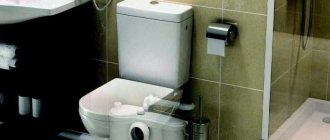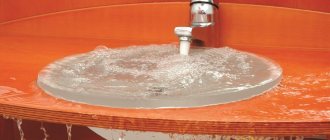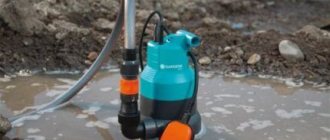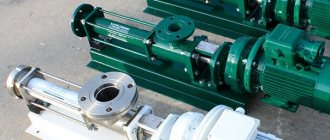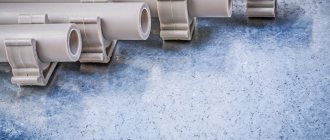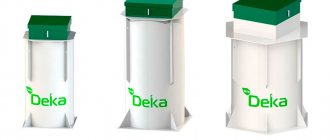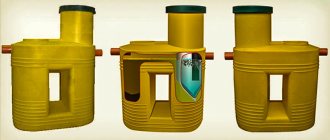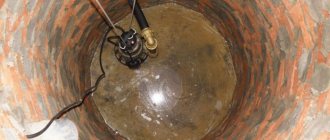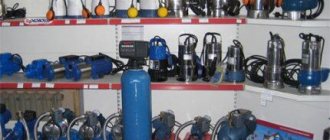In cases where gravity evacuation of wastewater is not possible, forced pumping units are used. Such equipment prevents the formation of blockages in drain systems and allows plumbing fixtures to function fully, regardless of their number and location in an apartment or private house. Today we will analyze in detail what Sololift for sewerage is, what problems such installations solve, and also talk about their advantages and disadvantages of devices.
Compact pumping station for sewerage
Sololift - what is it?
Owners of private houses and apartments quite often face the problem of difficult drainage of water into the sewer. To solve it, it is enough to install a pumping station to pump liquid.
Forced action pump for toilet
The best choice for ordinary people would be to purchase a compact Sololift device, which will ensure uninterrupted operation of the wastewater system. In addition, such equipment can be installed anywhere in a residential or utility room, regardless of the level at which the plumbing fixtures are located. Sololift is a household sewer pump that automatically and forcibly transports wastewater into the sewer pipeline.
There are models of devices with a mechanism for grinding the contents of the drain, which ensures its normal evacuation and eliminates the formation of blockages. A home forced sewer pump is capable of lifting wastewater to a height of 7-9 m with vertical pipes. This allows equipment to be installed in basements below the level of plumbing fixtures in the home.
Scheme of operation of the pumping station located below the drain point
The station is also capable of evacuating waste liquid over a distance of up to 100 m along a horizontal sewer line. Sololift pumping units have a stylish design and compact dimensions, so they are perfect for the interior of kitchens, toilets and bathrooms.
Advantages of the device
• compact body of laconic design;
• connects to small diameter pipes, which makes it possible to reduce costs on materials;
• suitable for use in residential premises, offices, public buildings;
• connects to pipelines of different diameters;
• some models pump clogged drains;
• simple installation;
• does not require complex maintenance;
• has a long service life.
Sololift sewer pump: solving problems with wastewater drainage in a private house
Sololift household appliances are used for forced pumping of liquids and sewage that cannot be drained by gravity. Such equipment makes it possible to install plumbing fixtures below the point of entry of the drain into the sewer pipe. For example, a bathroom or toilet can be moved to the basement.
Scheme of operation of the device with the grinding mechanism
In the presence of an old sewer system, drainage is often difficult due to the narrowing of the pipe lumen. This problem can be solved by installing a fecal pump with a grinder for the toilet. There is a carbon filter inside the station, which absorbs the unpleasant smell of sewage.
Article on the topic: Sewerage for a private home: how to correctly implement the project, the principle of operation, how to make calculations, selection of components, step-by-step photo instructions for performing installation work without errors, advice and recommendations from experts - read the material on our portal.
How to change the slope of a pipe
There are only two ways to change the slope of the pipe:
- lift a plumbing fixture (bathtub, sink, toilet, washing machine, etc.);
- make the entrance to the local or central collector lower.
Both of these methods involve significant difficulties. It is not always possible to raise a bathtub or toilet without affecting the ease of use, and it is even more difficult to lower the entrance to the central manifold.
Why do you need a sololift?
Sololift for Grundfos sewerage: advantages and disadvantages of equipment
Grundfos pumping stations are rightfully considered one of the best equipment for plumbing and sewer systems on the market. Sololift units have a durable body, and all structural parts are made of high-quality materials. This ensures equipment reliability and long service life.
Among the advantages of pumping systems, it should be noted that there is no need to carry out work to clean structural components. All models are made in such a way that impurities and debris do not accumulate in them. In addition, the operation of the device is characterized by a low noise level, which creates additional comfort from its use.
The small dimensions of Grundfos devices make the equipment compact and make it possible to install pumps even in limited space. Sololift copes well with thermal loads and is resistant to water pressure, so you don’t have to worry about pump breakdowns. The disadvantages of household pumping stations include the fact that the equipment operates from the mains and requires constant switching on. To ensure uninterrupted drainage of the sewer, care should be taken to connect the installation to an autonomous power source.
Pros and cons of the design
The equipment has the following advantages:
- efficient operation even when connected to a small diameter pipeline;
- small dimensions, the ability to install the device in confined spaces;
- convenient operation;
- a number of improved models have a vortex design, due to which blockages do not form in the system;
- no need to use expensive tools for installation;
- compatibility with various types of interior.
One of the disadvantages is the overpriced device. Another problem is complex repairs that are difficult to do on your own. Most owners turn to professional repairmen to fix breakdowns, which requires additional costs. On the other hand, with proper operation and initially correct installation, the system rarely needs maintenance.
Sololift design and equipment
The Sololift household installation consists of a storage tank (housing) and a pumping mechanism. There is a special sensor inside the device that monitors the liquid filling level.
Table 1. Structural components of the Sololift pumping station
| Equipment node | Image | Description |
| Storage tank | The station tank serves as a reservoir for liquid and feces. The housing is sealed and highly durable. | |
| Submersible pumping unit | The submersible pumping mechanism is installed inside the device housing. Designed for pumping and evacuating waste water into the sewer main. The pump works automatically, turns on and off depending on the water level in the tank (regulated by sensors). | |
| Shredder | The device consists of an impeller with cutting edges. Rotating, it crushes waste, which is then discharged into the drain pipe. Thanks to this mechanism, the formation of blockages in the pipe is eliminated. | |
| Check Valve | The valve prevents waste liquid from escaping from the pipeline back into the device. | |
| Carbon filter | Eliminates the spread of unpleasant odors in the room. | |
| Reception filter | Thanks to this device, large fractions and various items are collected in one place, from where they can be easily removed. The filter minimizes the risk of damage to the operating mechanisms of the device. |
How does the drainage system work?
Sololift2 Grundfos sewage pumping stations are equipped with an electric motor and a liquid level sensor. In addition, the structure is made of composite tanks, the storage tank has spherical walls, and the bottom is inclined in the direction of the pump.
This design and layout option minimizes the likelihood of sediment forming on the bottom and walls of the tank. The sensor ensures that the engine turns on only when necessary, which saves energy.
The principle of operation of pumping stations is as follows: wastewater flows into the tank and reaches the control level. The sensor gives the engine a start command, and the liquid is pumped into the public sewer system. When the level drops to the set values, the motor turns off and the pump stops working.
The principle of operation of the Sololift sewage pumping unit
The operating principle of household sewerage pumps is quite simple. There is a sensor inside the station device. As soon as the water reaches a certain level, it turns on and sends a signal to the pumping unit and the grinding device.
After they are activated, the liquid with processed sewage is transported into the main drainage system. Electrical equipment is switched off automatically. Depending on the number of points of consumption, a sewage pump in a private house or apartment may have several inlet pipes. They are used to connect plumbing fixtures. The installation also has an outlet through which the liquid is drained.
Advice! To connect equipment such as washing machines or dishwashers, as well as to organize the drainage of sinks and bathtubs, it is recommended to install models with a heat-resistant housing.
Rules of operation and maintenance
Maintenance of all sololift models involves systematic cleaning of the equipment and the filter system installed inside it. For this purpose, special detergent compositions are used.
Sequence of cleaning pumping equipment:
- Disconnect devices from the electrical network.
- Remove the top cover of the device.
- Pour detergent into the reservoir.
- Turn on the pump and drain the liquid.
- Pump the unit with running water.
- Close the unit cover.
The electrical power must be turned off when cleaning the filter, which is removed, washed and installed in its original place.
Some models are equipped with a magnetic float switch installed at different levels. During maintenance, such a float must be removed.
General technical characteristics of Sololift
For ease of perception of information and comparison of the main, additional characteristics of forced pumps, we suggest studying the following table.
Table 2. Purpose and technical characteristics of Sololift pumping stations
| Pumping station marking/Purpose | Power consumption, kW | Flow volume, l/min | Permissible temperature of liquid, °С | Pressure value, m |
| WC-1 – used to connect toilets and washbasins. | 0,62 | 149 | 50 | 8,5 |
| WC-3 – equipment for toilets, shower cabins, installation for bidets and washbasins. | 0,62 | 149 | 50 | 8,5 |
| CWC-3 – used to connect shower cabins, wall-mounted toilets, and washbasins. | 0,62 | 137 | 50 | 8,5 |
| C-3 – connection of washbasins, shower systems, bathtubs, washing machines, dishwashers, bidets. | 0,64 | 204 | 75 (90 - no longer than 30 minutes of use) | 8,5 |
| D-2 – equipment is used to connect bidets, showers, washbasins. | 0,28 | 119 | 50 | 5,5 |
S-3
The photo shows the operating principle of the S-3 installation.
The fundamental difference between the S-3 and other models is its ability to pump high-temperature wastewater. The unit operates at a water temperature of 75°C. Within 30 minutes it can transport water whose temperature is 90°C. There is no cutting mechanism included. Such equipment is connected to dishwashing and washing equipment, and to sinks. You cannot connect more than 3 water intake points at the same time.
Do-it-yourself toilet in the country: Schemes, drawings, photos and videos
The photo shows an example of connecting S-3.
The device has a magnetic float switch. The float installation level can be varied. It is removed during maintenance. The pump is equipped with an alarm signal.
The main parameters of S-3 are:
- weight – 6 kg 600 g;
- dimensions -158 mm x 493 mm x 341 mm;
- Tank capacity – 5.7 l.
The estimated cost of the product is 20,000 rubles.
Brief overview of popular Sololift models
There are a lot of popular and reputable manufacturers and brands on the market for such equipment. We suggest you study some models.
Pumping unit Sololift WC1
This type of toilet pump is equipped with a grinding mechanism. Thanks to this, feces, toilet paper and other items turn into a homogeneous mass, which is evacuated into the drain pipe and does not clog the drain. The device has motor overheat protection: as soon as the motor temperature reaches a critical point, the device turns off. After cooling down, the unit restarts automatically. The sewage pump with grinder has compact dimensions and can be easily installed behind the toilet.
The volume of the device’s reservoir is 9 liters, weight – 7.3 kg. For normal operation of the drainage system, it is recommended to install the device at a distance of up to 150 mm from the toilet. The installation is fixed on a horizontal surface using screws and dowels.
Pumping unit Sololift WC-1
Sewage installation Grundfos Sololift D-2
This equipment is used to drain liquid that does not contain impurities (solid particles, feces, etc.). It can be installed in a private house or apartment. The sewage pump for kitchens Sololift Grundfos D-2 is equipped with two inlets, which makes it possible to simultaneously connect 2 appliances at once.
Pumping station SololiftD-2 Grundfos
The equipment is characterized by economical energy consumption, as well as low noise and vibration levels. Distinctive features of the installation include:
- long warranty period from the manufacturer (up to 24 months);
- the presence of a dry electric motor rotor;
- absence of toxins in the material from which the body is made;
- ease of installation and configuration of equipment.
The weight of the pumping unit is 4.3 kg, the volume of the device’s reservoir is 2 liters. The pumping station operates from a household power supply of 220 V.
Sewage pump Sololift WC-3
WC-3 sewer station model can work not only as a pulverizer pump for a toilet, but also be used to connect sinks, bidets, bathtubs and showers. The sololift of this modification allows you to use three water consumption points and a toilet at the same time.
Pump Sololift WC-3
The pumping station structure weighs 7.3 kg and its capacity is 9 liters. A special feature of the model is the presence of a vortex-type hydraulic forced system, which effectively eliminates the formation of blockages. The unit body is made of high-strength polymer. The high level of equipment tightness completely minimizes the risk of leakage.
Sololift D-3 installation
The SololiftD-3 model is used for draining wastewater (without solid impurities and toilet paper) from bathrooms and kitchens. This pump is able to ensure the operation of 3 devices simultaneously, for which the corresponding number of holes is provided in the design.
Sololift D-3
The equipment is installed below the drain point of the sewer system. The weight of this Sololift model for sink, bidet and shower is 3.5 kg. The pump is capable of pumping liquid up to 60 l/min, and the maximum delivery height is 5.5 m.
Grundfos Sololift C-3 system
The equipment is designed for connecting washing machines, dishwashers, showers, sinks and kitchen sinks to the sewer line. The sewage pump model C-3 has drainage holes in its design that allow 3 devices to be operated simultaneously.
Expert opinion
Valery Drobakhin
VK design engineer (water supply and sewerage) ASP North-West LLC
Ask a specialist
“The pumping station model is not equipped with a grinder, so it cannot be used to connect to the toilet. It also prevents food waste from entering the sewer system, which could cause damage to the unit.”
Sololift S-3 is used to drain large volumes of liquid. This pumping unit is able to remove wastewater whose temperature reaches 90°C.
Model of Sololift station Grundfoss S-3
Step-by-step installation diagram
- Dismantling the toilet, placing a pumping station.
- Installing a drain pipe from a sink or sink.
- Making a hole in the plug to connect the drain pipe.
- Securely fix the plug in place and check the serviceability of the check valve.
- Installation of the adapter onto the plug with fixation using a clamp.
- Closing an unused hole with a plug after installing the pipe.
- Securing the pressure pipe.
- Making a hole in the plastic cover and fixing it to the body.
- Connection of an elbow pipe with fastening with a clamp.
- Pipe connection.
- Covering the drain hole.
- Floor fixation of the device.
- Installation and connection of the toilet.
- Connecting the device to the power supply.
For maximum reliability and proper operation of the system, it is recommended to entrust the installation to a specialist.
Subsequent cleaning and maintenance can be carried out independently. To do this, turn off the electricity supply, remove the cover of the device and pour in the solvent. After the time specified in the instructions, the pump is connected to the network and the liquid is drained. To get a consultation
How to choose a Sololift sewer pump for a toilet and sink - recommendations from our editors
Before buying a Sololift for sewerage, you should first study the technical parameters of the device, as well as decide on the intended use. If renovation work is to be done in the house with subsequent redevelopment and relocation of equipment, preference should be given to pumping stations with several inlets.
Types of devices compatible with Grundfos pumping stations
It is extremely important to take into account the maximum water temperature at which normal operation of the equipment is allowed. Also, when choosing a pumping station, you need to take into account the method of its installation, since the higher it is located, the greater the power consumption will be. If you choose the wrong installation (in terms of power and performance), there is a high probability that the pump will not withstand the load and will burn out. For this reason, you should select a system with a small margin of basic technical parameters. We offer you to watch a video that will allow you to quickly understand the criteria for choosing Sololift pumping systems.
Video “Criteria for selecting Sololift pumping stations”:
A few words about Sololift markings
When choosing a pumping unit, you need to pay attention to the product labeling. This nuance determines the installation location, functionality and everyday tasks that can be solved using the equipment.
The manufacturer uses capital letters of the Latin alphabet to label products. It looks like this:
- WC – these models have a built-in grinding mechanism. The station is designed for the removal of black (fecal) waste and can be connected to floor-mounted toilets.
- CWC - this category of equipment is also equipped with a grinder and is designed for the removal of fecal waste. However, such models are designed for wall-hung toilets.
- C and D – pumps for removing gray (fecal-free) wastewater, suitable for any plumbing fixtures except toilets.
In addition, the marking of each product includes a numerical designation: 1-3 . This indicates the number of additional outlets in addition to the main drain. Essentially, the numbers indicate the number of plumbing fixtures connected to the pump.
Installation of forced sewage pump Sololift
Despite the ease of installation work on installing Sololift pumps, you should follow some rules to avoid mistakes. The drain pipe should not have any bends, as this will make it difficult to push out the drain water. If you plan to install a pumping station to drain liquid from shower cabins (bathrooms), it is recommended to connect the equipment at the lowest points. In addition, the drain must be equipped with a filtration system to prevent hair and other small objects from getting inside the equipment.
Option for installing a pumping station in a toilet
Before carrying out installation work, it is necessary to check the installation package and make sure that there is a check valve (if it is missing, dirty water will flow back into the system). You also need to install a material on the floor under the unit that will absorb the vibrations of the pump. The pipes must be tightly connected to each other using sealant and seals. As a rule, manufacturers include all the components necessary for installation, so there is no need to purchase screws and other fasteners.
Connecting the pump connections
Upon completion of installation work, the system is checked for connection quality. If leaks occur, it is necessary to eliminate defects at the joints.
Installation Features
During installation, it is extremely important to ensure the correct angle of inclination of the pumping equipment, otherwise the movement of waste will be difficult. You can do the installation yourself; the equipment comes with instructions. To work, you will need several straight screwdrivers (8 and 2.5 mm), pliers with an opening of 5 cm, a socket wrench and a wrench. In order for the system to operate without interruption, installation must be completed in the required sequence. Algorithm of actions:
- Select pipeline elements, sealing parts, sealant, and other consumables.
- Fix the Sololift pump on the vibration-isolating material, maintaining a minimum distance of 10 mm to the wall or connected consumer.
- Connect the required devices (toilet, sink, bathtub, bidet, etc.) to the outlet pipes.
- Treat connection points and joints with sealant. It is important to choose a substance with water-resistant properties, otherwise leaks will quickly appear.
- Secure the outlet pipe with pliers and connect the pump to the power supply.
Upon completion of the work, you will need to check the system for operability, test the pump itself, and make sure that there are no water leaks in the network. If you do not have the skills or tools, it is recommended to entrust installation work to specialists so as not to encounter problems in the future use of the sewer.
Maintenance and repair of the Sololift pump
Table 3. Main types of faults and methods for solving them
| Type of failure | Description of the malfunction | Solution |
| Jamming, overheating of the electric motor | The engine jams or it overheats greatly due to solid objects getting inside the unit. | Cleaning the drain station. Engine replacement. |
| Temperature violation | The engine overheats and fails. This occurs due to incorrect selection of the installation, which is not able to provide drainage of hot liquid. | Replacement of the pumping station with an installation with suitable parameters. |
| Constant heating of the electric motor | The motor heats up due to untimely cleaning of the structural components of the system. | Motor repair. Replacement of the pipeline with a larger diameter line. |
| Pump failure due to freezing | The pump freezes in winter in unheated rooms, as a result of which the structure becomes deformed. | Repair or replacement of the pump. |
| Engine burnout | Damage occurs as a result of water entering the motor. | Unit diagnostics. Eliminating the causes of moisture getting into the engine. |
| Sticking, combustion of the electric motor | When draining thick or sticky liquids, its rotating parts stick. | Replacing the electric motor. |
The removed power unit of the pumping unit
The principle of maintenance of forced drainage systems for Grundfos Sololift sewerage is to comply with the fluid temperature specified by the manufacturer and periodic inspection. It is also necessary to prevent all kinds of objects and aggressive chemical compounds from getting inside the unit.
Preventing a dirty pump
Connection to sewerage
Connecting the sololift to the sewer system provides for a distance to the plumbing fixture of no more than 50 m. Increasing the distance will lead to disruption of the station. The sololift system for sewerage provides the correct slope of the pipes after vertical lifting. If pipes are laid at the wrong angle, the operation of the sewer system will be disrupted and the likelihood of blockages will increase.
Dependence of pipe diameter on distance
To connect to plumbing fixtures, it is made using adapters included in the delivery package of the sololift. The device itself must be firmly fixed to the floor.
Connection using flexible adapters
At what price can you profitably buy Sololift for sewerage?
Table 4. Average cost of Sololift pumping units
| Image | Pumping unit model | Price in rubles (current as of April 2021) |
| Grundfos Sololift2 WC-1 | 22000 | |
| Grundfos Sololift2 WC-3 | 27300 | |
| Grundfos Sololift2 CWC-3 | 27800 | |
| Grundfos Sololift2 C-3 | 24300 | |
| Grundfos Sololift2 D-2 | 18300 | |
| Grundfos Sololift D-3 | 16800 |
Features of the Sololift+ model range
Sololift+ models are available in a white plastic case, the differences between them lie in the differentiation of the area of use, there are also differences in the configuration. Such pumping units are designed to serve residential premises and offices. They are sensitive to chemicals, fats, and cannot process any waste except toilet paper. So don't put garbage down the drains. If the wastewater may contain the components listed above, it is recommended to purchase other Grundfos equipment designed for pumping clogged wastewater.
The photo shows a table of correspondence between Sololift+ installations and sanitary equipment
The Sololift Plus complex includes the following varieties:
C-3 , where C indicates that the installation has a width of 120 mm; D-3 , where D indicates that the pump can be used for a shower or sink; WC is a symbol indicating that the unit is equipped with a cutting mechanism that allows you to connect the pump to the toilet; if there are no additional numbers, then such an installation is mounted only to the toilet; WC-1 , 1 – one additional pipe with a diameter of 40 mm; WC-3 , 3 – three pipes; CWC-3 .
Sololift pumps for toilets and sinks - consumer reviews
Review of the Grundfos Sololift2 WC-3 model:
More details on Otzovik:
Review of the Grundfos Sololift2 CWC-3 model:
More details on Otzovik:
Review of the Grundfos Sololift2 D-2 model:
More details on Otzovik:
Dear readers of Seti.guru magazine! We invite you to share in discussions your feedback on the use of Grundfos Sololift pumping stations, as well as your own experience in carrying out repair and installation work on this equipment.
CWC-3
In the photo – Sololift CWC-3.
This equipment is characterized by limited dimensions and the presence of a grinding part. This pump is installed on all types of plumbing fixtures: toilet, sink, bidet. Such a unit installed in a wall niche looks harmonious. Its dimensions allow the device to be placed in a limited area. A powerful electric motor and a high-quality shredder are not afraid of either toilet paper or feminine hygiene products. The rounded shape of the bottom eliminates deposits. If problems occur during operation, a sound signal sounds. The equipment is equipped with protection against overheating, and self-restart is possible.
The parameters of this equipment are as follows:
- weight – 7 kg 100 g;
- dimensions – 538.4 mm x 495.1 mm x 164.2 mm;
- Tank capacity – 9 l.
The above installation costs approximately 22,000 rubles.
